TOYOTA MIRAI 2020 Warranties & Maintenance Guides (in English)
Manufacturer: TOYOTA, Model Year: 2020, Model line: MIRAI, Model: TOYOTA MIRAI 2020Pages: 52, PDF Size: 0.54 MB
Page 21 of 52
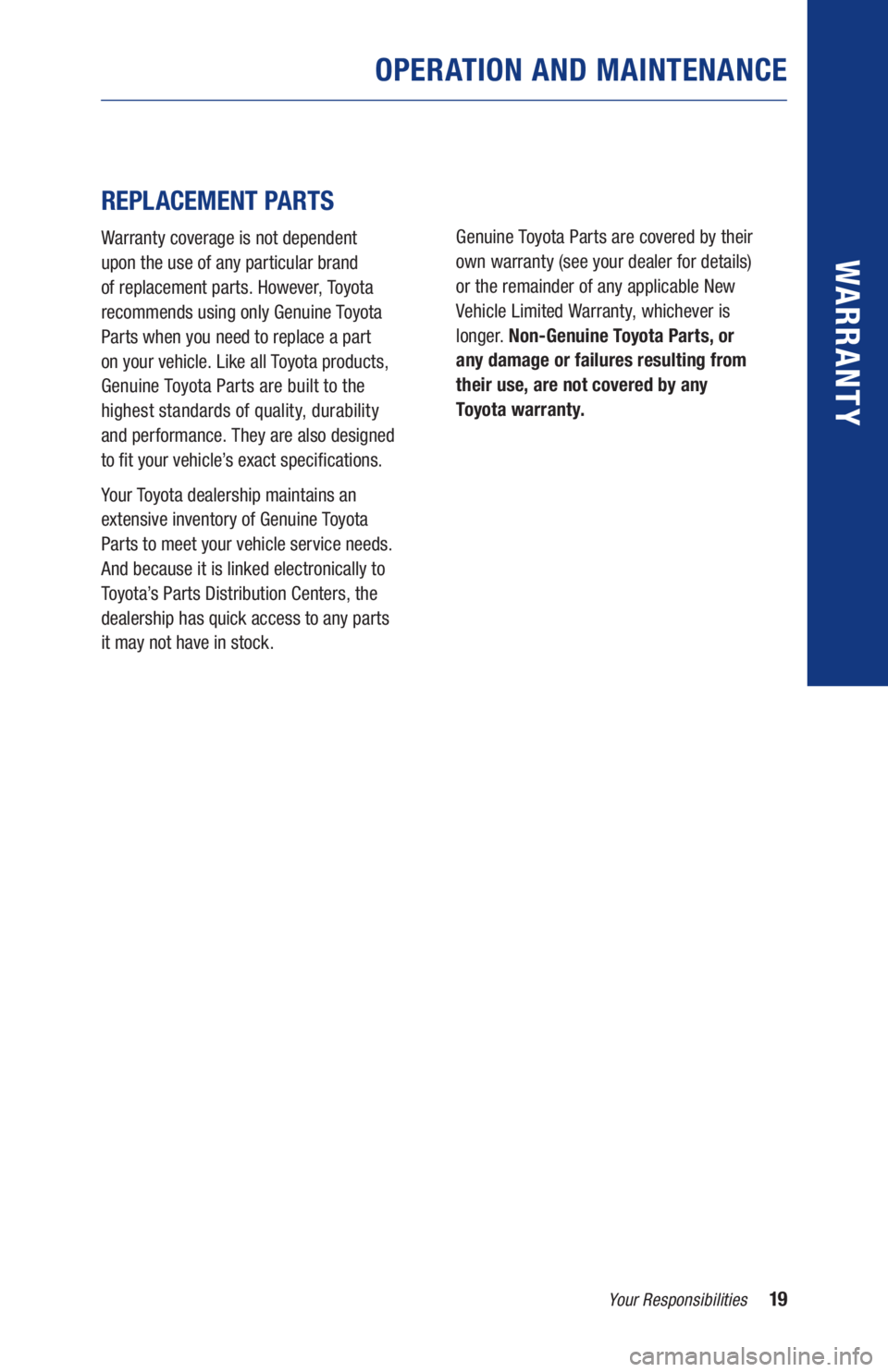
19Your Responsibilities
WARR ANT Y
REPLACEMENT PARTS
Warranty coverage is not dependent
upon the use of any particular brand
of replacement parts. However, Toyota
recommends using only Genuine Toyota
Parts when you need to replace a part
on your vehicle. Like all Toyota products,
Genuine Toyota Parts are built to the
highest standards of quality, durability
and performance. They are also designed
to fit your vehicle’s exact specifications.
Your Toyota dealership maintains an
extensive inventory of Genuine Toyota
Parts to meet your vehicle service needs.
And because it is linked electronically to
Toyota’s Parts Distribution Centers, the
dealership has quick access to any parts
it may not have in stock.
Genuine Toyota Parts are covered by their
own warranty (see your dealer for details)
or the remainder of any applicable New
Vehicle Limited Warranty, whichever is
longer. Non-Genuine Toyota Parts, or
any damage or failures resulting from
their use, are not covered by any
Toyota warranty.
OPERATION AND MAINTENANCE
Page 22 of 52
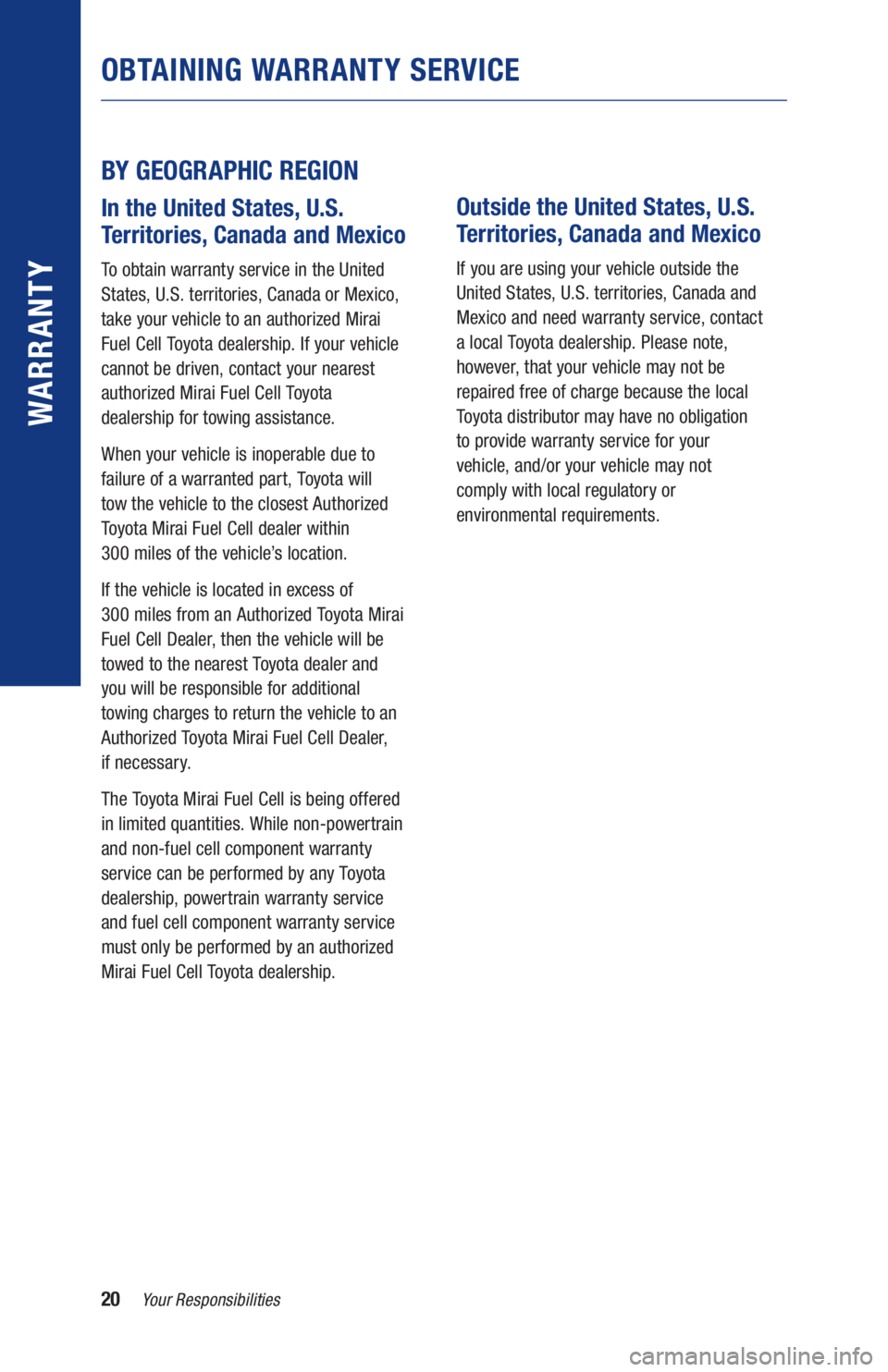
20Your Responsibilities
WARR ANT Y
BY GEOGRAPHIC REGION
In the United States, U.S.
Territories, Canada and Mexico
To obtain warranty service in the United
States, U.S. territories, Canada or Mexico,
take your vehicle to an authorized Mirai
Fuel Cell Toyota dealership. If your vehicle
cannot be driven, contact your nearest
authorized Mirai Fuel Cell Toyota
dealership for towing assistance.
When your vehicle is inoperable due to
failure of a warranted part, Toyota will
tow the vehicle to the closest Authorized
Toyota Mirai Fuel Cell dealer within
300 miles of the vehicle’s location.
If the vehicle is located in excess of
300 miles from an Authorized Toyota Mirai
Fuel Cell Dealer, then the vehicle will be
towed to the nearest Toyota dealer and
you will be responsible for additional
towing charges to return the vehicle to an
Authorized Toyota Mirai Fuel Cell Dealer,
if necessary.
The Toyota Mirai Fuel Cell is being offered
in limited quantities. While non-powertrain
and non-fuel cell component warranty
service can be performed by any Toyota
dealership, powertrain warranty service
and fuel cell component warranty service
must only be performed by an authorized
Mirai Fuel Cell Toyota dealership.
Outside the United States, U.S.
Territories, Canada and Mexico
If you are using your vehicle outside the
United States, U.S. territories, Canada and
Mexico and need warranty service, contact
a local Toyota dealership. Please note,
however, that your vehicle may not be
repaired free of charge because the local
Toyota distributor may have no obligation
to provide warranty service for your
vehicle, and/or your vehicle may not
comply with local regulatory or
environmental requirements.
OBTAINING WARRANTY SERVICE
Page 23 of 52
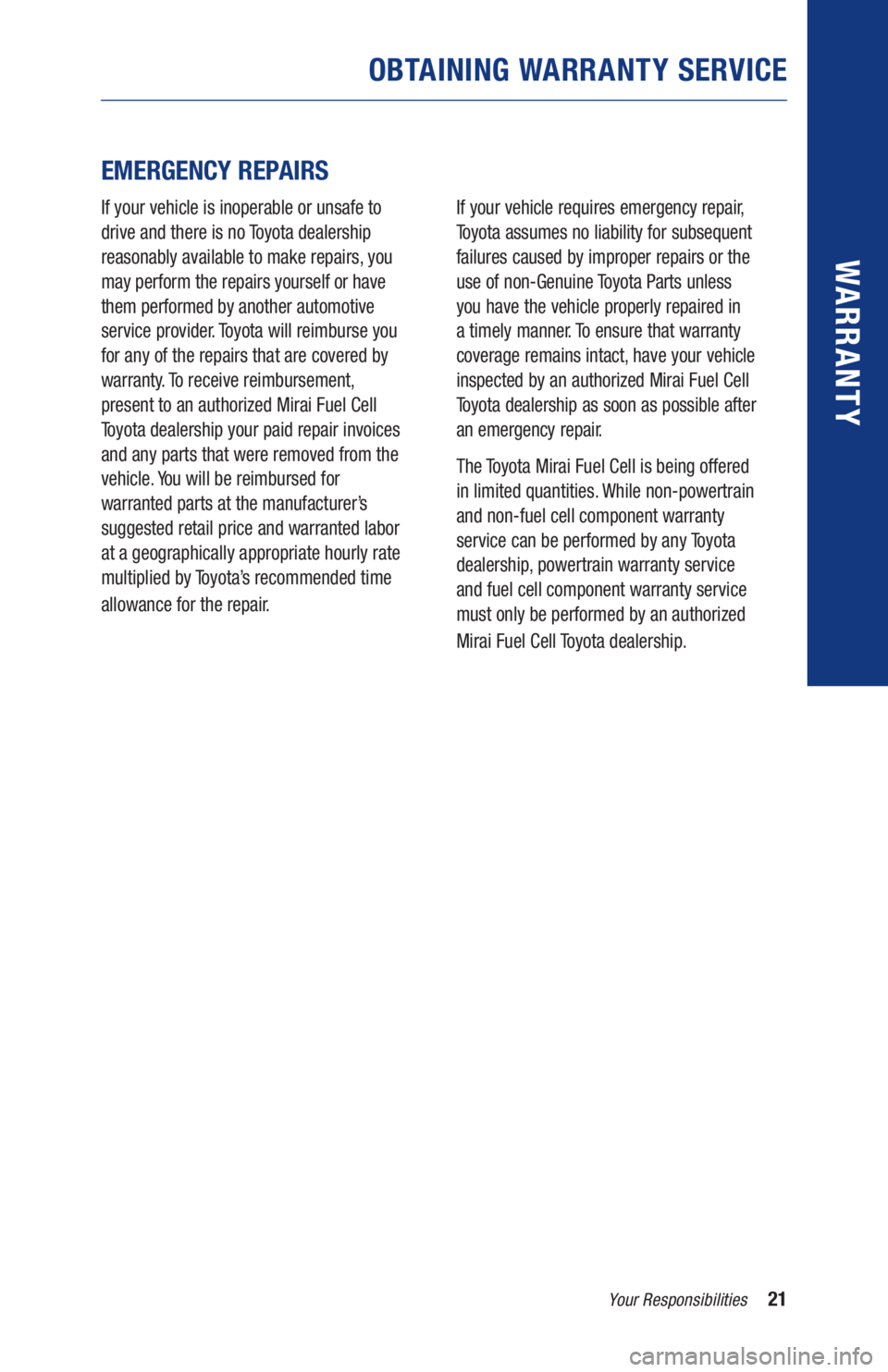
21Your Responsibilities
WARR ANT Y
EMERGENCY REPAIRS
If your vehicle is inoperable or unsafe to
drive and there is no Toyota dealership
reasonably available to make repairs, you
may perform the repairs yourself or have
them performed by another automotive
service provider. Toyota will reimburse you
for any of the repairs that are covered by
warranty. To receive reimbursement,
present to an authorized Mirai Fuel Cell
Toyota dealership your paid repair invoices
and any parts that were removed from the
vehicle. You will be reimbursed for
warranted parts at the manufacturer’s
suggested retail price and warranted labor
at a geographically appropriate hourly rate
multiplied by Toyota’s recommended time
allowance for the repair.
If your vehicle requires emergency repair,
Toyota assumes no liability for subsequent
failures caused by improper repairs or the
use of non-Genuine Toyota Parts unless
you have the vehicle properly repaired in
a timely manner. To ensure that warranty
coverage remains intact, have your vehicle
inspected by an authorized Mirai Fuel Cell
Toyota dealership as soon as possible after
an emergency repair.
The Toyota Mirai Fuel Cell is being offered
in limited quantities. While non-powertrain
and non-fuel cell component warranty
service can be performed by any Toyota
dealership, powertrain warranty service
and fuel cell component warranty service
must only be performed by an authorized
Mirai Fuel Cell Toyota dealership.
OBTAINING WARRANTY SERVICE
Page 24 of 52
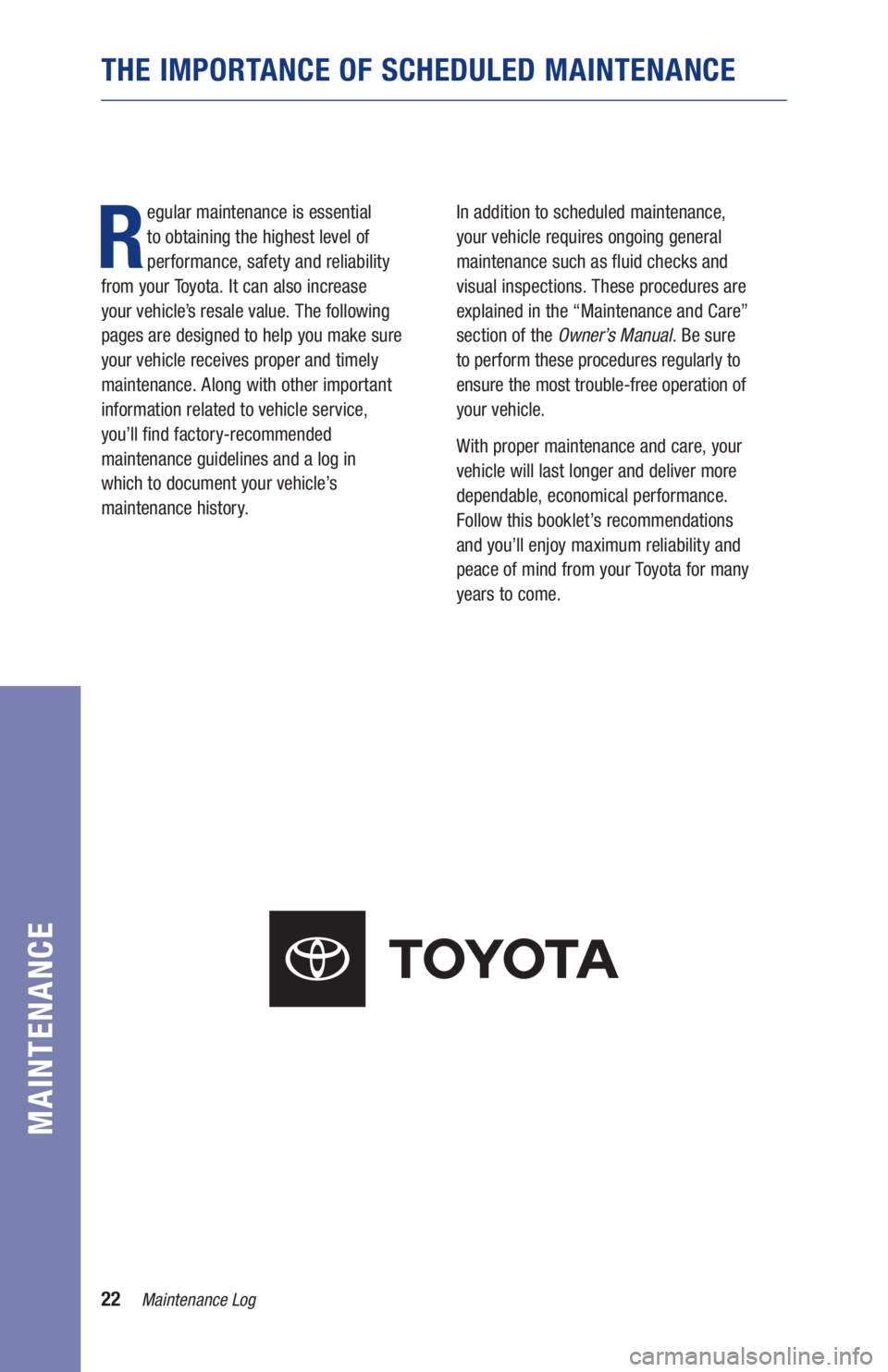
22Maintenance Log
MAINTENANCE
R
egular maintenance is essential
to obtaining the highest level of
performance, safety and reliability
from your Toyota. It can also increase
your vehicle’s resale value. The following
pages are designed to help you make sure
your vehicle receives proper and timely
maintenance. Along with other important
information related to vehicle service,
you’ll find factory-recommended
maintenance guidelines and a log in
which to document your vehicle’s
maintenance history.In addition to scheduled maintenance,
your vehicle requires ongoing general
maintenance such as fluid checks and
visual inspections. These procedures are
explained in the “Maintenance and Care”
section of the Owner’s Manual. Be sure
to perform these procedures regularly to
ensure the most trouble-free operation of
your vehicle.
With proper maintenance and care, your
vehicle will last longer and deliver more
dependable, economical performance.
Follow this booklet’s recommendations
and you’ll enjoy maximum reliability and
peace of mind from your Toyota for many
years to come.
THE IMPORTANCE OF SCHEDULED MAINTENANCE
Page 25 of 52
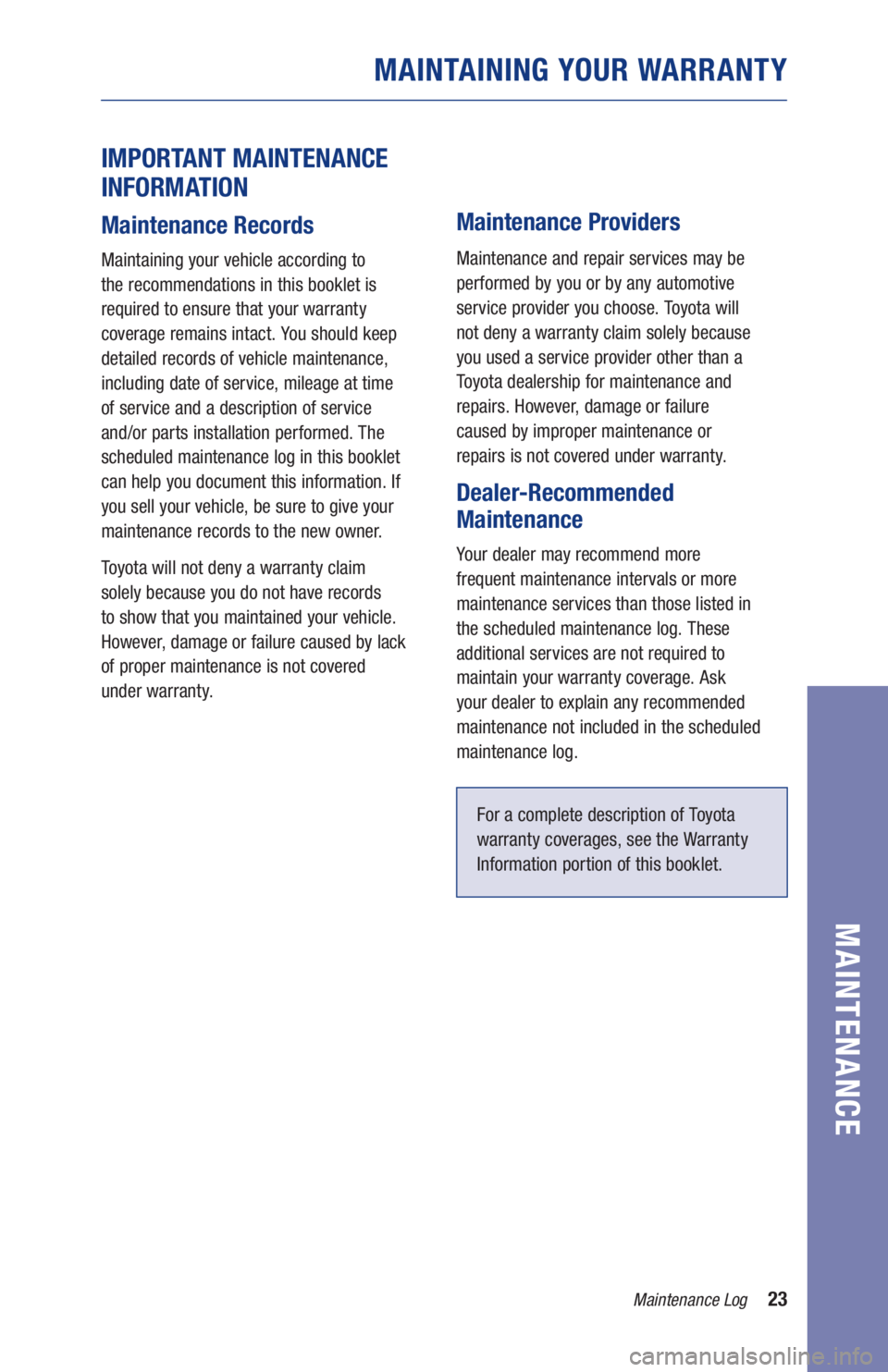
23Maintenance Log
MAINTENANCE
IMPORTANT MAINTENANCE
INFORMATION
Maintenance Records
Maintaining your vehicle according to
the recommendations in this booklet is
required to ensure that your warranty
coverage remains intact. You should keep
detailed records of vehicle maintenance,
including date of service, mileage at time
of service and a description of service
and/or parts installation performed. The
scheduled maintenance log in this booklet
can help you document this information. If
you sell your vehicle, be sure to give your
maintenance records to the new owner.
Toyota will not deny a warranty claim
solely because you do not have records
to show that you maintained your vehicle.
However, damage or failure caused by lack
of proper maintenance is not covered
under warranty.
Maintenance Providers
Maintenance and repair services may be
performed by you or by any automotive
service provider you choose. Toyota will
not deny a warranty claim solely because
you used a service provider other than a
Toyota dealership for maintenance and
repairs. However, damage or failure
caused by improper maintenance or
repairs is not covered under warranty.
Dealer-Recommended
Maintenance
Your dealer may recommend more
frequent maintenance intervals or more
maintenance services than those listed in
the scheduled maintenance log. These
additional services are not required to
maintain your warranty coverage. Ask
your dealer to explain any recommended
maintenance not included in the scheduled
maintenance log.
For a complete description of Toyota
warranty coverages, see the Warranty
Information portion of this booklet.
MAINTAINING YOUR WARRANTY
Page 26 of 52
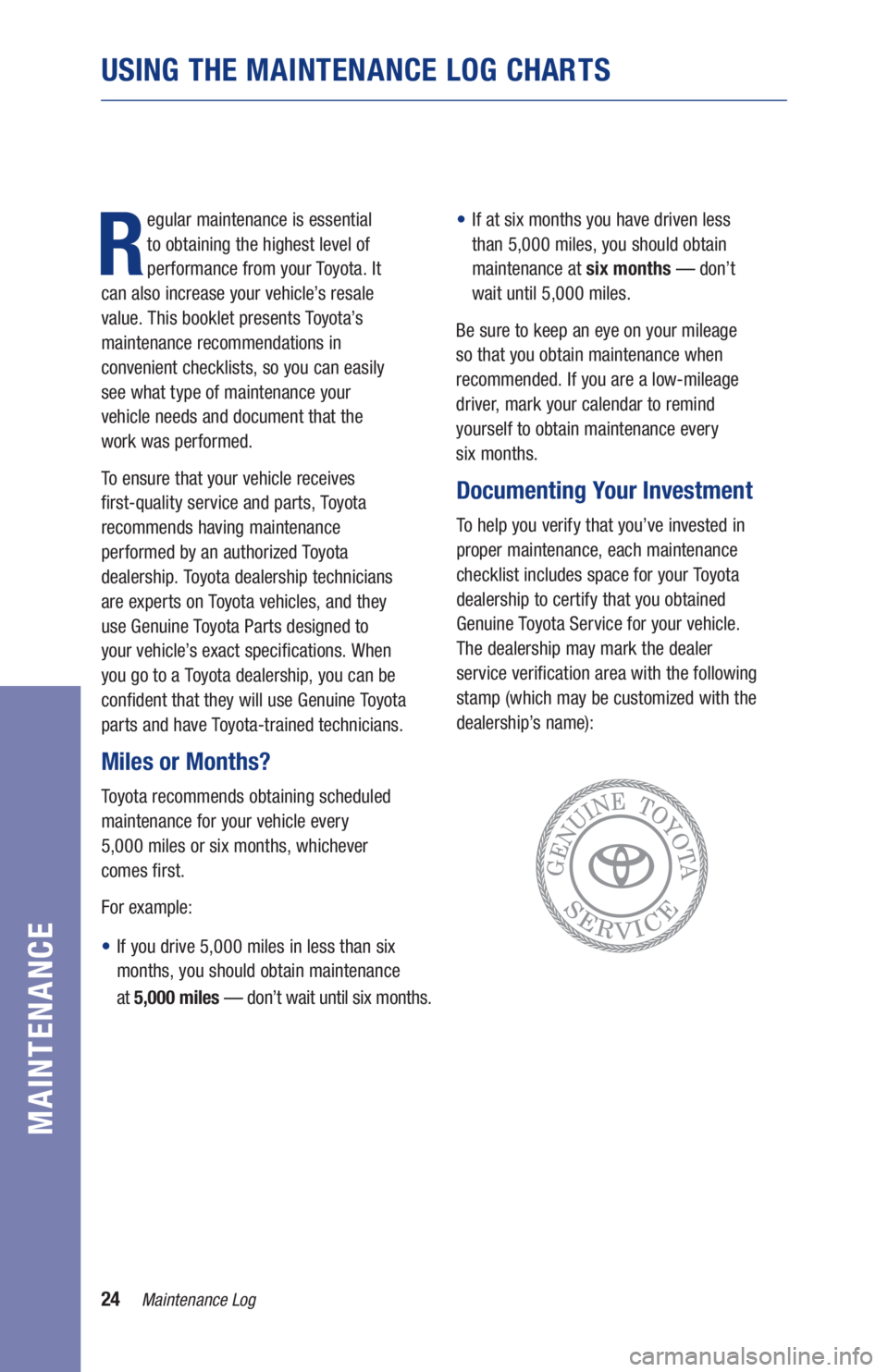
24Maintenance Log
MAINTENANCE
USING THE MAINTENANCE LOG CHARTS
R
egular maintenance is essential
to obtaining the highest level of
performance from your Toyota. It
can also increase your vehicle’s resale
value. This booklet presents Toyota’s
maintenance recommendations in
convenient checklists, so you can easily
see what type of maintenance your
vehicle needs and document that the
work was performed.
To ensure that your vehicle receives
first-quality service and parts, Toyota
recommends having maintenance
performed by an authorized Toyota
dealership. Toyota dealership technicians
are experts on Toyota vehicles, and they
use Genuine Toyota Parts designed to
your vehicle’s exact specifications. When
you go to a Toyota dealership, you can be
confident that they will use Genuine Toyota
parts and have Toyota-trained technicians.
Miles or Months?
Toyota recommends obtaining scheduled
maintenance for your vehicle every
5,000 miles or six months, whichever
comes first.
For example:
• If you drive 5,000 miles in less than six
months, you should obtain maintenance
at 5,000 miles — don’t wait until six months.
• If at six months you have driven less
than 5,000 miles, you should obtain
maintenance at six months — don’t
wait until 5,000 miles.
Be sure to keep an eye on your mileage
so that you obtain maintenance when
recommended. If you are a low-mileage
driver, mark your calendar to remind
yourself to obtain maintenance every
six months.
Documenting Your Investment
To help you verify that you’ve invested in
proper maintenance, each maintenance
checklist includes space for your Toyota
dealership to certify that you obtained
Genuine Toyota Service for your vehicle.
The dealership may mark the dealer
service verification area with the following
stamp (which may be customized with the
dealership’s name):
Page 27 of 52
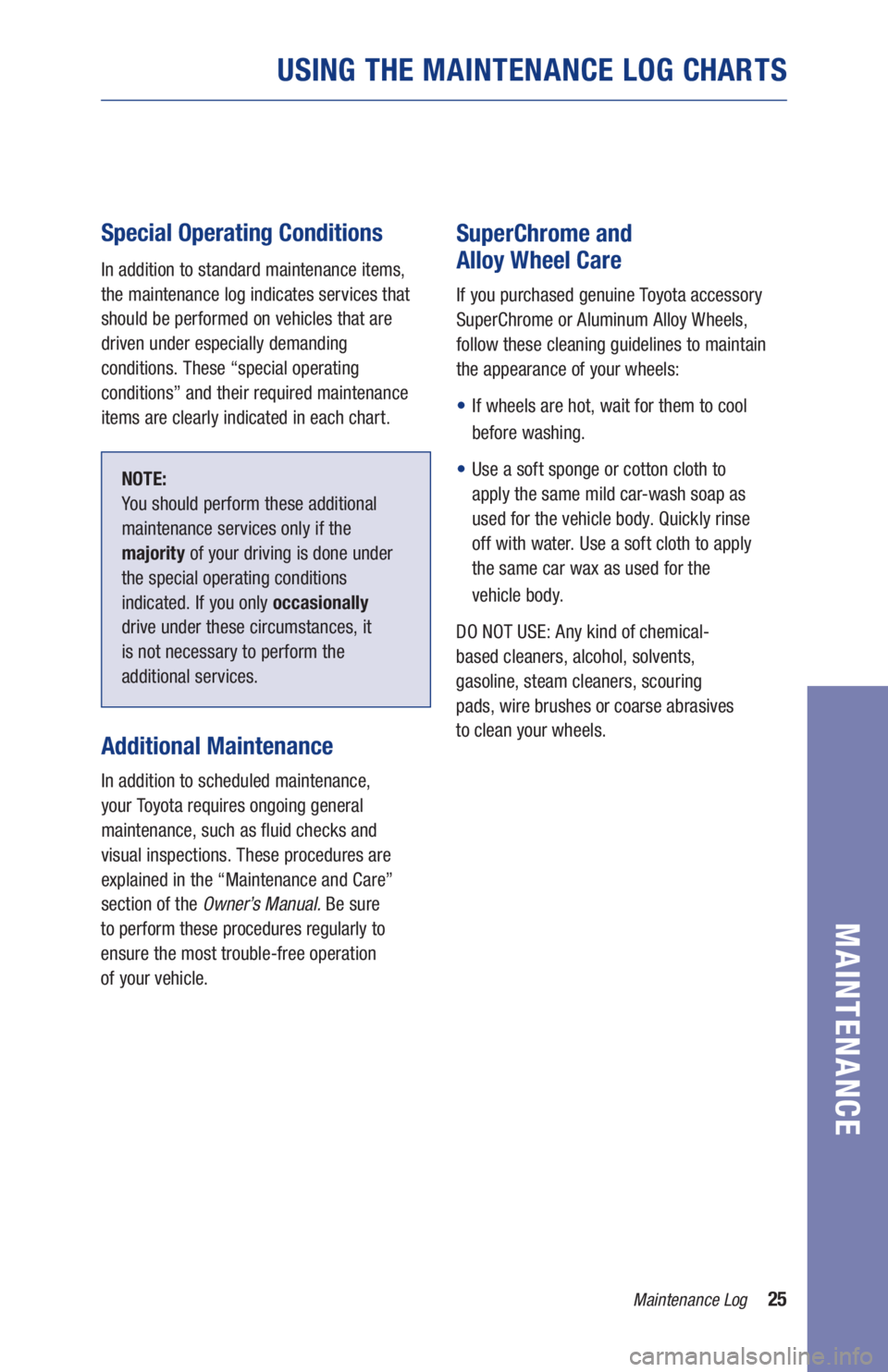
25Maintenance Log
MAINTENANCE
USING THE MAINTENANCE LOG CHARTS
Special Operating Conditions
In addition to standard maintenance items,
the maintenance log indicates services that
should be performed on vehicles that are
driven under especially demanding
conditions. These “special operating
conditions” and their required maintenance
items are clearly indicated in each chart.
NOTE:
You should perform these additional
maintenance services only if the
majority of your driving is done under
the special operating conditions
indicated. If you only occasionally
drive under these circumstances, it
is not necessary to perform the
additional services.
Additional Maintenance
In addition to scheduled maintenance,
your Toyota requires ongoing general
maintenance, such as fluid checks and
visual inspections. These procedures are
explained in the “Maintenance and Care”
section of the Owner’s Manual. Be sure
to perform these procedures regularly to
ensure the most trouble-free operation
of your vehicle.
SuperChrome and
Alloy Wheel Care
If you purchased genuine Toyota accessory
SuperChrome or Aluminum Alloy Wheels,
follow these cleaning guidelines to maintain
the appearance of your wheels:
• If wheels are hot, wait for them to cool
before washing.
• Use a soft sponge or cotton cloth to
apply the same mild car-wash soap as
used for the vehicle body. Quickly rinse
off with water. Use a soft cloth to apply
the same car wax as used for the
vehicle body.
DO NOT USE: Any kind of chemical-
based cleaners, alcohol, solvents,
gasoline, steam cleaners, scouring
pads, wire brushes or coarse abrasives
to clean your wheels.
Page 28 of 52
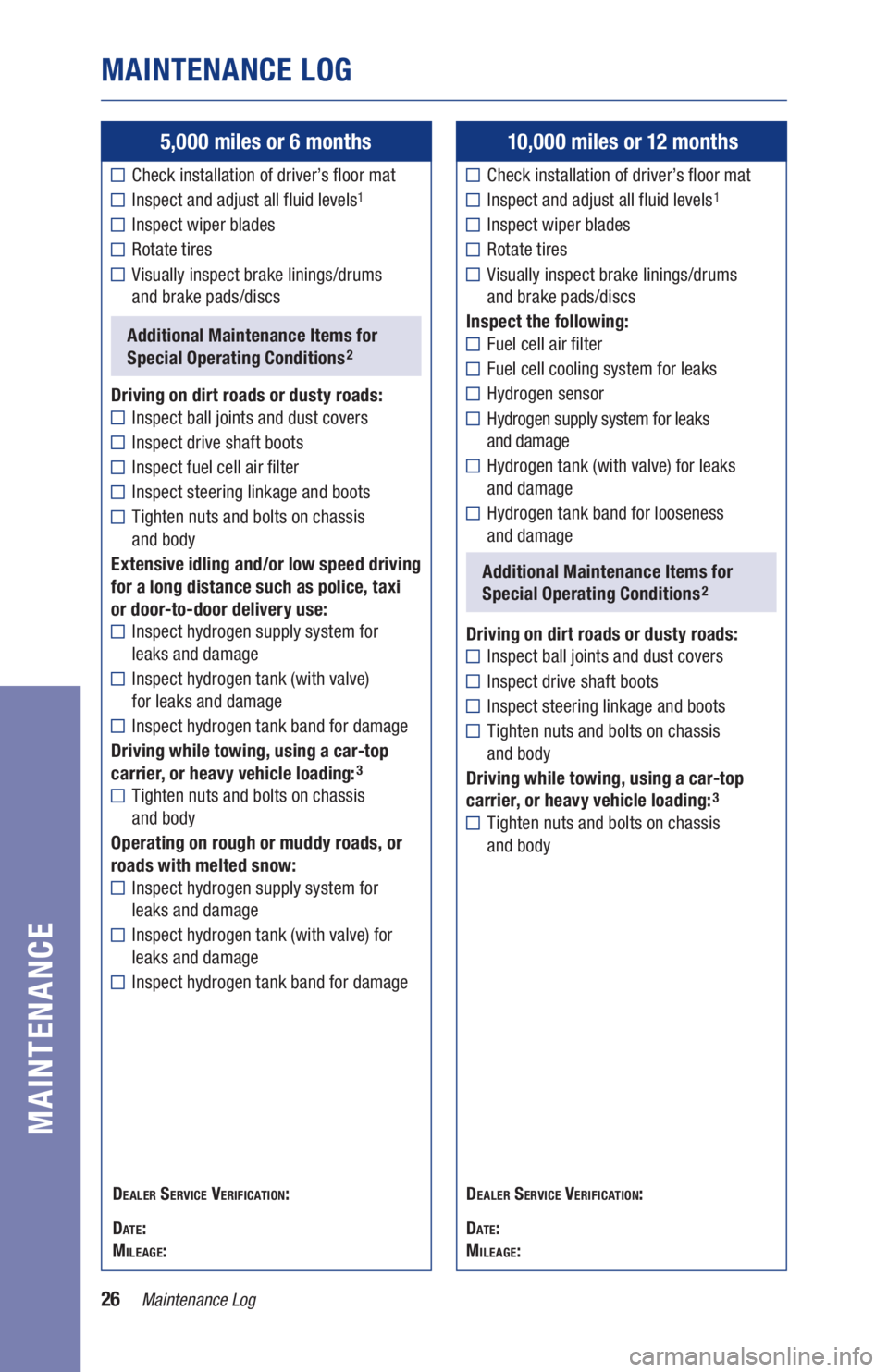
26Maintenance Log
MAINTENANCE LOG
MAINTENANCE
5,000 miles or 6 months
Check installation of driver’s floor mat
Inspect and adjust all fluid levels1
Inspect wiper blades
Rotate tires
Visually inspect brake linings/drums
and brake pads/discs
Additional Maintenance Items for
Special Operating Conditions2
Driving on dirt roads or dusty roads:Inspect ball joints and dust covers
Inspect drive shaft boots
Inspect fuel cell air filter
Inspect steering linkage and boots
Tighten nuts and bolts on chassis
and body
Extensive idling and/or low speed driving
for a long distance such as police, taxi
or door-to-door delivery use:
Inspect hydrogen supply system for
leaks and damage
Inspect hydrogen tank (with valve)
for leaks and damage
Inspect hydrogen tank band for damage
Driving while towing, using a car-top
carrier, or heavy vehicle loading:
3
Tighten nuts and bolts on chassis
and body
Operating on rough or muddy roads, or
roads with melted snow:
Inspect hydrogen supply system for
leaks and damage
Inspect hydrogen tank (with valve) for
leaks and damage
Inspect hydrogen tank band for damage
10,000 miles or 12 months
Check installation of driver’s floor mat
Inspect and adjust all fluid levels1
Inspect wiper blades
Rotate tires
Visually inspect brake linings/drums
and brake pads/discs
Inspect the following:
Fuel cell air filter
Fuel cell cooling system for leaks
Hydrogen sensor
Hydrogen supply system for leaks
and damage
Hydrogen tank (with valve) for leaks
and damage
Hydrogen tank band for looseness
and damage
Additional Maintenance Items for
Special Operating Conditions2
Driving on dirt roads or dusty roads:Inspect ball joints and dust covers
Inspect drive shaft boots
Inspect steering linkage and boots
Tighten nuts and bolts on chassis
and body
Driving while towing, using a car-top
carrier, or heavy vehicle loading:
3
Tighten nuts and bolts on chassis
and body
DEALER SERVICE VERIFICATION:
D
ATE:
MILEAGE:D
EALER SERVICE VERIFICATION:
D
ATE:
MILEAGE:
Page 29 of 52
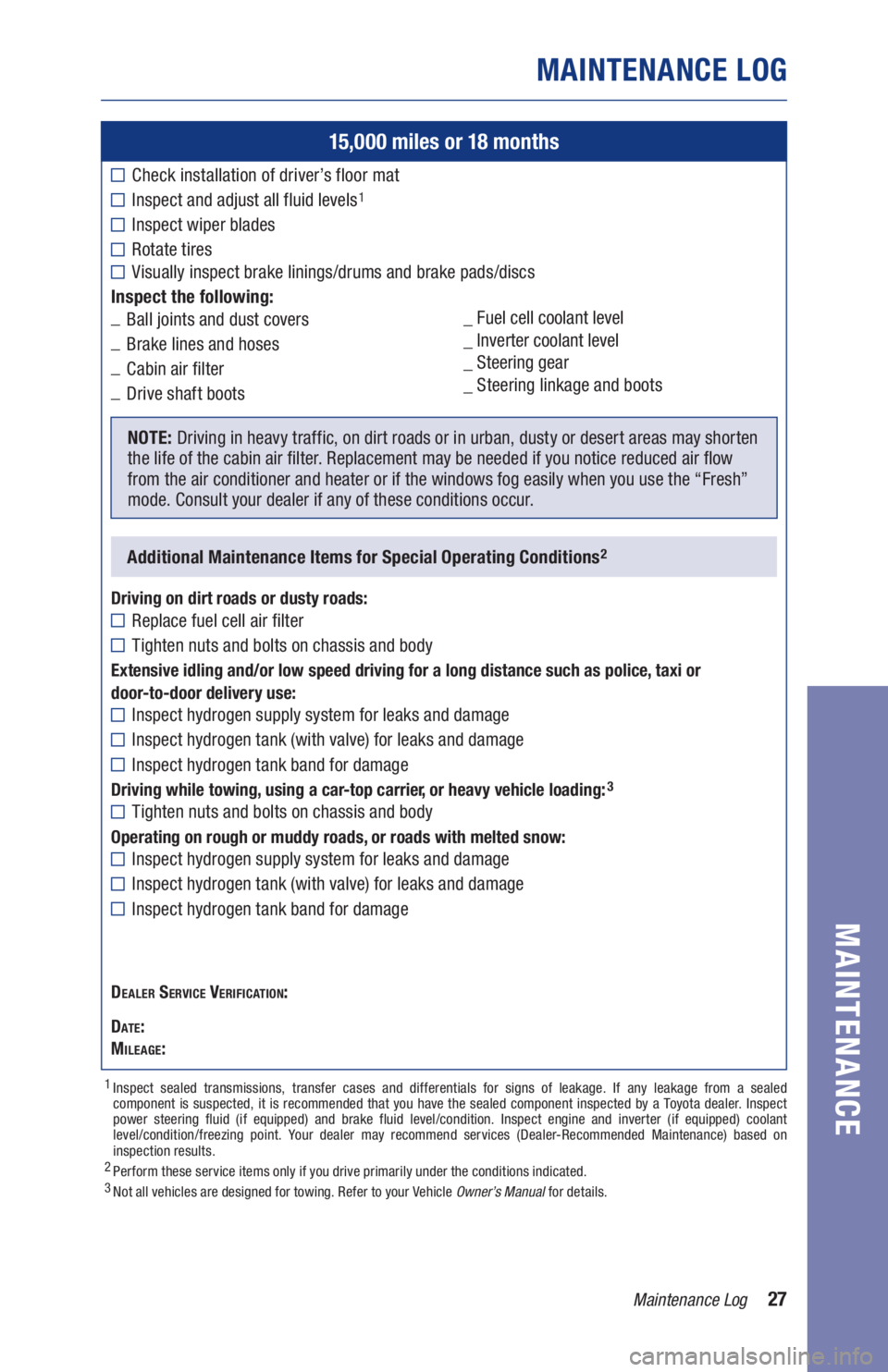
27Maintenance Log
MAINTENANCE LOG
MAINTENANCE
15,000 miles or 18 months
Check installation of driver’s floor mat
Inspect and adjust all fluid levels1
Inspect wiper blades
Rotate tires Visually inspect brake linings/drums and brake pads/discs
Inspect the following:
_
Ball joints and dust covers
_
Brake lines and hoses
_
Cabin air filter
_
Drive shaft boots
Additional Maintenance Items for Special Operating Conditions2
Driving on dirt roads or dusty roads:Replace fuel cell air filter
Tighten nuts and bolts on chassis and body
Extensive idling and/or low speed driving for a long distance such as police, taxi or
door-to-door delivery use:
Inspect hydrogen supply system for leaks and damage
Inspect hydrogen tank (with valve) for leaks and damage
Inspect hydrogen tank band for damage
Driving while towing, using a car-top carrier, or heavy vehicle loading:3
Tighten nuts and bolts on chassis and body
Operating on rough or muddy roads, or roads with melted snow:Inspect hydrogen supply system for leaks and damage
Inspect hydrogen tank (with valve) for leaks and damage
Inspect hydrogen tank band for damage
NOTE: Driving in heavy traffic, on dirt roads or in urban, dusty or desert areas may shorten
the life of the cabin air filter. Replacement may be needed if you notice reduced air flow
from the air conditioner and heater or if the windows fog easily when you use the “Fresh”
mode. Consult your dealer if any of these conditions occur.
1 Inspect sealed transmissions, transfer cases and differentials for signs of leakage. If any leakage from a sealed
component is suspected, it is recommended that you have the sealed component inspected by a Toyota dealer. Inspect
power steering fluid (if equipped) and brake fluid level/condition. Inspect engine and inverter (if equipped) coolant
level/condition/freezing point. Your dealer may recommend services (Dealer-Recommended Maintenance) based on
inspection results.
2
Perform these service items only if you drive primarily under the conditions indicated.3
Not all vehicles are designed for towing. Refer to your Vehicle Owner’s Manual for details.
_ Fuel cell coolant level
_ Inverter coolant level
_ Steering gear
_ Steering linkage and boots
DEALER SERVICE VERIFICATION:
D
ATE:
MILEAGE:
Page 30 of 52
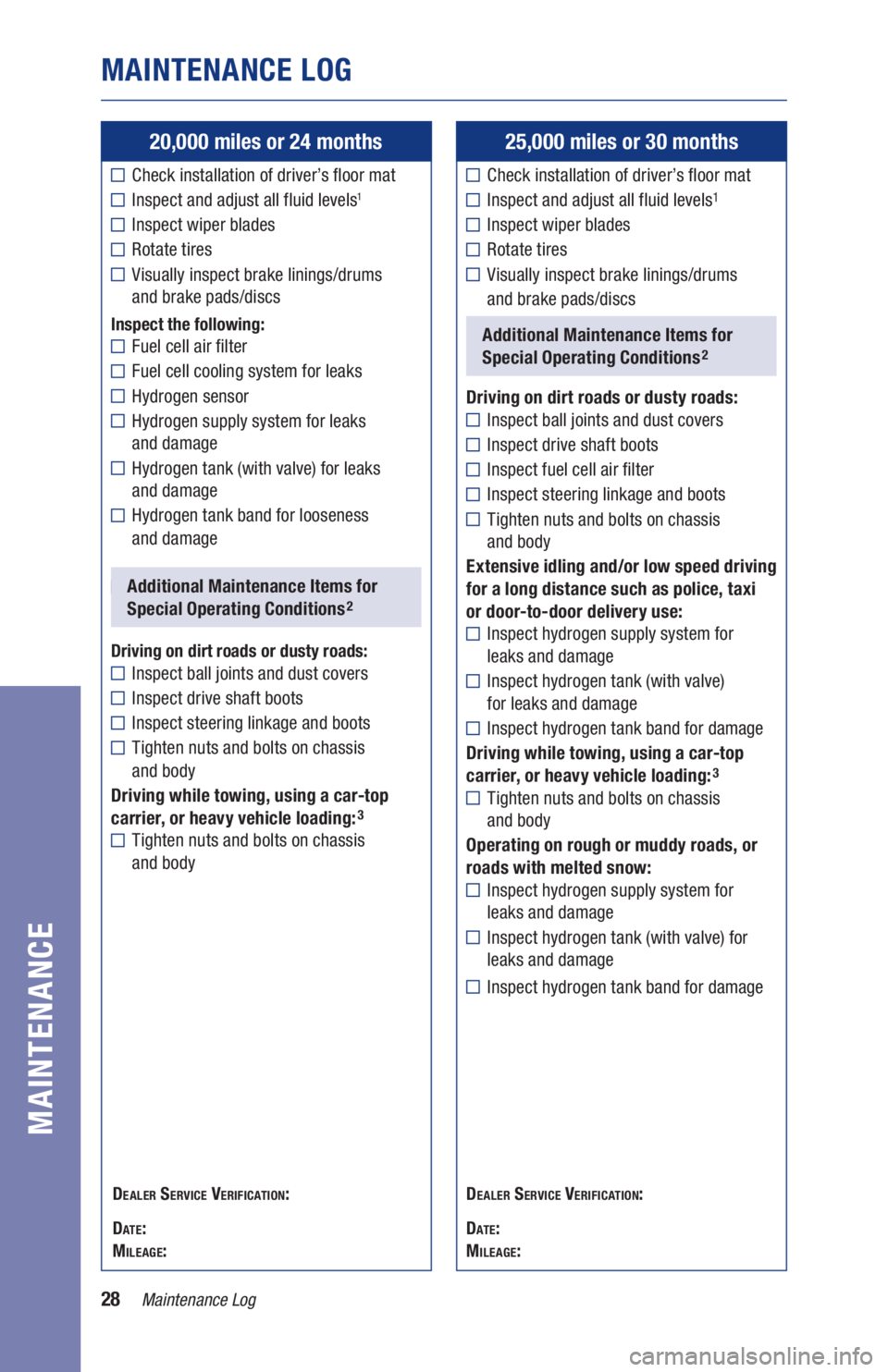
28Maintenance Log
MAINTENANCE LOG
MAINTENANCE
20,000 miles or 24 months
Check installation of driver’s floor mat
Inspect and adjust all fluid levels1
Inspect wiper blades
Rotate tires
Visually inspect brake linings/drums
and brake pads/discs
Inspect the following:Fuel cell air filter
Fuel cell cooling system for leaks
Hydrogen sensor
Hydrogen supply system for leaks
and damage
Hydrogen tank (with valve) for leaks
and damage
Hydrogen tank band for looseness
and damage
Additional MainteAdditional Maintenance Items for
Special Operating Conditions2
Driving on dirt roads or dusty roads:Inspect ball joints and dust covers
Inspect drive shaft boots
Inspect steering linkage and boots
Tighten nuts and bolts on chassis
and body
Driving while towing, using a car-top
carrier, or heavy vehicle loading:
3
Tighten nuts and bolts on chassis
and body
25,000 miles or 30 months
Check installation of driver’s floor mat
Inspect and adjust all fluid levels1
Inspect wiper blades
Rotate tires
Visually inspect brake linings/drums
and brake pads/discs
Additional Maintenance Items for
Special Operating Conditions2
Driving on dirt roads or dusty roads:Inspect ball joints and dust covers
Inspect drive shaft boots
Inspect fuel cell air filter
Inspect steering linkage and boots
Tighten nuts and bolts on chassis
and body
Extensive idling and/or low speed driving
for a long distance such as police, taxi
or door-to-door delivery use:
Inspect hydrogen supply system for
leaks and damage
Inspect hydrogen tank (with valve)
for leaks and damage
Inspect hydrogen tank band for damage
Driving while towing, using a car-top
carrier, or heavy vehicle loading:
3
Tighten nuts and bolts on chassis
and body
Operating on rough or muddy roads, or
roads with melted snow:
Inspect hydrogen supply system for
leaks and damage
Inspect hydrogen tank (with valve) for
leaks and damage
Inspect hydrogen tank band for damage
DEALER SERVICE VERIFICATION:
D
ATE:
MILEAGE:D
EALER SERVICE VERIFICATION:
D
ATE:
MILEAGE: